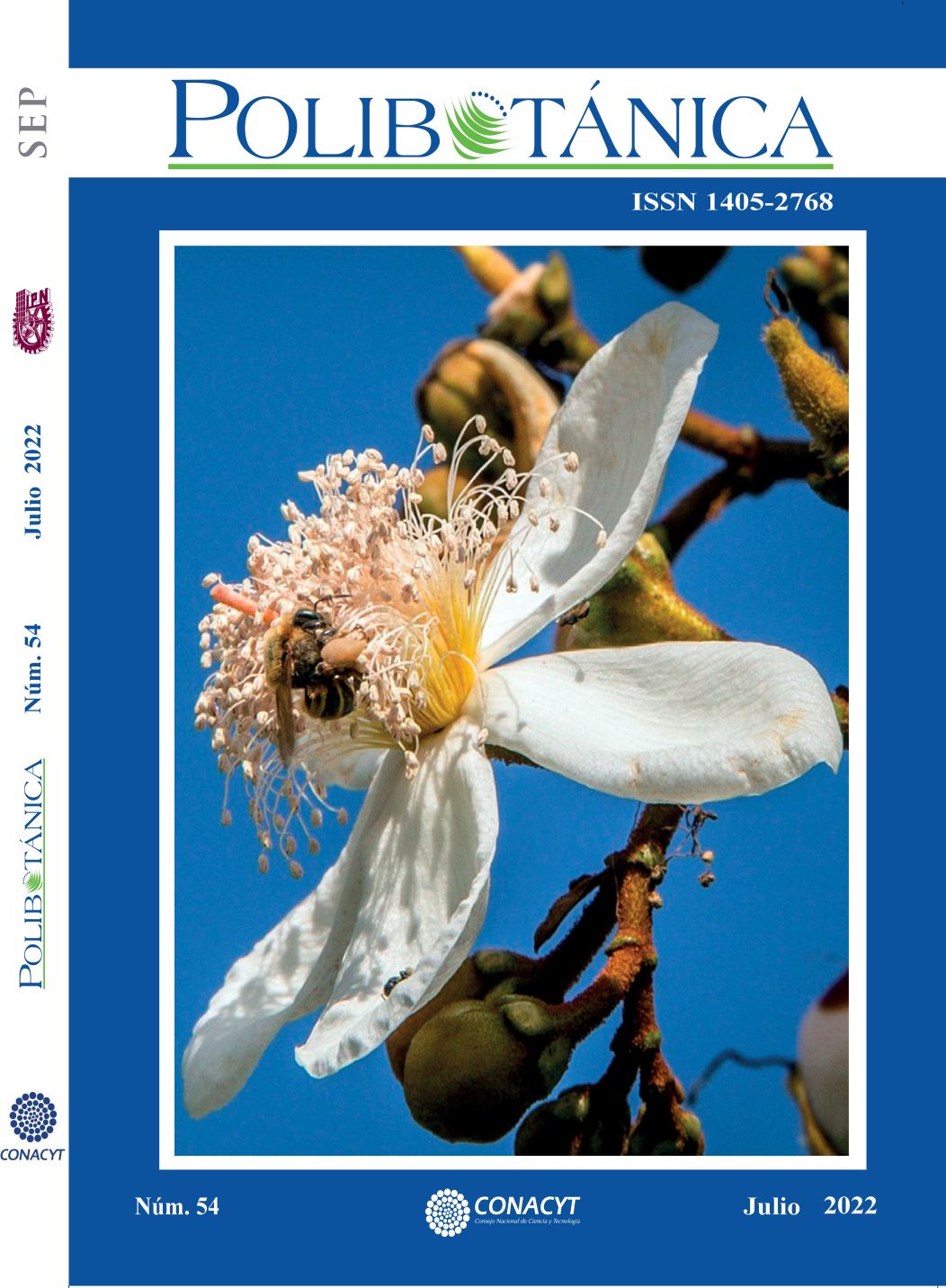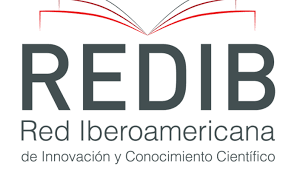Yield components of Crotalaria longirostrata Hook . & Arn. in Guerrero, Mexico
DOI:
https://doi.org/10.18387/polibotanica.54.7Keywords:
cápsulas, chipilín, racimos, ramas, semillas, valvasAbstract
Young plants of Crotalaria longirostrata Hook. & Arn. are food for humans and animals and have been used in herbal medicine since pre-Hispanic times in Mexico and Central America. The plants are collected in situ and also grown incipiently. Seeds are needed for commercial cultivation, which could be obtained from plants in situ. The objective of this study was to evaluate the seed yield and other yield components of the wild plants of C. longirostrata. Plants in reproductive stage were collected in Las Vigas, Ometepec, and Llano Grande de los Hilarios Igualapa, Guerrero, Mexico. The number of branches, clusters, capsules and seeds per plant, per cluster and per branch, the diameter, length and biomass of the capsules and seeds were quantified. Soil samples from the collection sites were analyzed. Yield components varied significantly (P ≤ 0.05) within and between locations. The number of branches per plant (9 to 24), seeds per cluster (102 to 132), seeds per branch (297 to 568) and per plant (3054 to 10,707) was higher in Las Vigas, with sandy loam soil, with lower field capacity and permanent wilting point, but cationic exchange capacity, and content of exchangeable P and K with respect to the other sites. Regardless of location, plants in the wild produce thousands of seeds.
References
Basurto-Peña, F. (2011). Los quelites de México: especies de uso actual. En: Mera LM, Castro LD, Bye R, eds. Especies vegetales poco valoradas: una alternativa para la seguridad alimentaria.
Bibi, Y., Arshad, M., Ahmad, N., Riaz, I., & Chaudhari, S. K. (2015). An insight into medicinal and ethnopharmacological potential of Crotalaria burhia. Asian Pacific Journal of Tropical Disease, 5(7). https://doi.org/10.1016/S2222-1808(15)60826-X
Bye R. (1981). Quelites-ethnobiology of edible green-past, present and future. Journal of Ethnobiology , 1, 109–123.
Camarillo-Castillo, F., & Mangan, F. X. (2020). Biological nitrogen fixation in chipilin (Crotalaria longirostrata Hook. & Arn.), a sustainable nitrogen source for commercial production. Revista Chapingo Serie Horticultura, 26(2), 125–141. https://doi.org/10.5154/r.rchsh.2020.01.002
Castiñeiras, A., Fundora, M., Shagarodsky, S., Fuentes, F., Barrios, G., Moreno, F., Sánchez, P., González A, A., Martínez, F., García, G., & Martínez, R. (2000). La conservación in situ de la variabilidad de plantas de cultivo en dos localidades de Cuba. Revista Del Jardín Botánico Nacional, 21, 25–45. https://doi.org/doi.org/10.5154/r.rchsh.2020.01.002
Castro-Lara, D., Bye-Boettler, R., Basurto-Peña, F., Mera-Ovando, L., Rodríguez-Servin, J., Álvarez-Vega, J., Morales de León, J., & Caballero-Roque, A. (2014). Revalorización, conservación y promoción de quelites: una tarea conjunta. AGROProductividad , 7, 8–13.
Centurión, D., Espinosa, M., Poot, M., & Cázares, C. (2003). Cultura alimentaria tradicional de la Región Sierra de Tabasco.
Chávez, E., Roldán TJ, Sotelo O, B., Ballinas, D., & López, Z. (2009). Plantas comestibles no convencionales en Chiapas, México. Revista Salud Pública y Nutrición, 10, 1–10.
Cruz-Rodríguez, R. I., Cruz-Salomón, A., Ruiz-Lau, N., Pérez-Villatoro, J. I., Esquinca-Avilés, H. A., & Meza-Gordillo, R. (2020). Potential Application of Crotalaria longirostrata Branch Extract to Reduce the Severity of Disease Caused by Fusarium. Agronomy, 10(4). https://doi.org/10.3390/agronomy10040524
Cruz-Rodríguez, R. I., Meza-Gordillo, R., Rodríguez-Mendiola, M. A., Arias-Castro, C., Mancilla-Margalli, N. A., Ávila-Miranda, M. E., Culebro-Ricaldi, J. M., Gutiérrez-Miceli, F. A., Ruiz-Valdiviezo, V. M., & Ayora-Talavera, T. D. R. (2017). Antifungal activity of Crotalaria longirostrata Hook. & Arn. extracts against phytopathogen fungi from maize. Gayana. Botánica, ahead. https://doi.org/10.4067/S0717-66432017005000102
Desaeger, J., & Rao, M. . (2000). Parasitic nematode populations in natural fallows and improved cover crops and their effects on subsequent crops in Kenya. Field Crops Research, 65(1). https://doi.org/10.1016/S0378-4290(99)00071-4
Devendra, B. N., Srinivas, N., & Solmon, K. S. (2012). A comparative pharmacological and phytochemical analysis of in vivo & in vitro propagated Crotalaria species. Asian Pacific Journal of Tropical Medicine, 5(1). https://doi.org/10.1016/S1995-7645(11)60242-3
Fischler, M., & Wortmann, C. S. (1999). Green manures for maize-bean systems in eastern Uganda: Agronomic performance and farmers’ perceptions. Agroforestry Systems, 47(1/3). https://doi.org/10.1023/A:1006234523163
García, E. (2004). Modificaciones al sistema de clasificación climática de Köppen. Instituto de Geografía, Universidad Nacional Autónoma de México.
Guerra-Centeno, D., Valdez-Sandoval, J., Villatoro, F., Rodenas, M., Fuentes-Rousselin, H., Díaz, M., & Ríos, L. (2015). Crecimiento de la cría de tilapia nilótica (Oreochromis niloticus) utilizando hojas de chipilín (Crotalaria longirostrata) como sustituto parcial del alimento balanceado. Revista Electrónica de Veterinaria, 17, 1–12.
Guerrero, G. (1999). Cultivos herbáceos extensivos.
Hall, A. (1980). Los componentes fisiológicos del rendimiento de los cultivos. Revista de La Facultad de Agronomía, 1(1), 73–86.
Herbario CICY, U. de R. N. (2010). Flora de la Península de Yucatán. Https://Www.Cicy.Mx/Sitios/Flora Digital/Ficha_virtual.Php?Especie=1588.
IUSS Working Group WRB. (2015). Base referencial mundial del recurso suelo 2014 .
Jacobi, C. M., Ramalho, M., & Silva, M. (2005). Pollination Biology of the Exotic Rattleweed Crotalaria retusa L. (Fabaceae) in NE Brazil1. Biotropica, 37(3). https://doi.org/10.1111/j.1744-7429.2005.00047.x
Jiménez-Aguilar, D., & Grusak, M. (2015). Evaluation of Minerals, Phytochemical Compounds and Antioxidant Activity of Mexican, Central American, and African Green Leafy Vegetables. Plant Foods for Human Nutrition, 70, 357–364.
Jiménez S, A., Farfán, V., & Morales L, C. (2005). Biomasa seca y contenido de nutrientes de Cajanus cajan, Crotalaria juncea y Tephrosia candida, empleadas como abonos verdes en cafetales. Cenicafé , 56, 93–109.
Laguna G, J. (2016). Determinación de la actividad biológica y caracterización de extractos del chipilín (Crotalaria longirostrata) con potencial aplicación en alimentos. Universidad Autónoma Agraria Antonio Narro.
Linares, M., & Bye, B. (2015). Las especies subutilizadas de la milpa. Revista Digital Universitaria, 16.
Martínez C, T. (2016). Evaluación de cinco fuentes alimenticias en la reproducción de caracoles de agua dulce (Pomacea flagellata). Universidad de El Salvador.
McClung de Tapia, E., Martínez Y, D., Ibarra M, E., & Adriano M, C. (2014). Los orígenes prehispánicos de una tradición alimentaria en la cuenca de México. Anales de Antropología, 48(1), 97–121.
Meagher J, R., Watrous, K., Fleischer, S., Nagoshi, R., Brown, J., Miller, N., Hight, S., Legaspi, J., & Westbrook, J. (2019). Documenting potential sunnhemp (Crotalaria juncea L.) (Fabaceae) pollinators in Florida. Environmental Entomology, 48, 343–359. https://doi.org/https://doi.org/10.1093/ee/nvy190
Miranda-Granados, J., Chacón, C., Ruiz-Lau, N., Vargas-Díaz, M., Zepeda, L., Alvarez-Gutiérrez, P., Meza-Gordillo, R., & Lagunas-Rivera, S. (2018). Alternative Use of Extracts of Chipilín Leaves (Crotalaria longirostrata Hook. & Arn) as Antimicrobial. Sustainability, 10(3). https://doi.org/10.3390/su10030883
Morton, J. F. (1994). Pito (Erythrina berteroana) and chipilin (Crotalaria longirostrata), (fabaceae) two soporific vegetables of Central America. Economic Botany, 48(2). https://doi.org/10.1007/BF02908199
Pardo-Aguilar, N., Lagunes-Espinoza, L. C., Salgado-García, S., Hernández-Nataren, E., & Bolaños-Aguilar, E. D. (2021). Chipilín (C. longirostrata Hook. and Arn.) Capacity for Regrowth and Leaf Area Production in Response to Nitrogen and Phosphorus Fertilizer Application. Legume Research - An International Journal, Of. https://doi.org/10.18805/LR-503
Patrick, J. W., & Colyvas, K. (2014). Crop yield components – photoassimilate supply- or utilisation limited-organ development? Functional Plant Biology, 41(9). https://doi.org/10.1071/FP14048
Peña-Valdivia, C., Aguirre R, R., & Arroyo-Peña, V. (2012). El frijol silvestre: Síndrome de domesticación. Colegio de Postgraduados.
Rojas-García, A., Maldonado-Peralta, M. de los A., Álvarez-Vázquez, P., Sánchez-Santillán, P., Ayala-Monter, M., & Ramírez-Reynoso, O. (2021). Scarification treatments in chepil seeds (Crotalaria longirostrata Hook. & Arn.) used to improve their germination. AGROProductividad, 14(2), 67–72.
Romero-Sánchez, I., Peña-Valdivia, C. B., García-Esteva, A., & Aguilar-Benítez, G. (2020). Caracterización seminal y del desarrollo de Oenothera rosea L’Hér. ex Ait. en invernadero. Polibotánica, 0(50). https://doi.org/10.18387/polibotanica.50.4
Rzedowski, J., Calderón de Rzedowski, G., Torres, C., & Grether, R. (2016). Flora del Bajío y de regiones adyacentes: Leguminosae (Subfamilia Papilionoideae (Aeschynomene- Diphysa) (Vol. 192). Instituto de Ecología, Centro Regional del Bajío.
Solís Bonilla, J. L., Muñoz Orozco, A., Escalante Estrada, J. A. S., & Zamarripa Colmenero, A. (2017). Crecimiento de variedades y componentes del rendimiento de higuerilla (Ricinus communis L.) en Montecillo, Estado de México. Revista Mexicana de Ciencias Agrícolas, 7(2). https://doi.org/10.29312/remexca.v7i2.346
Sosa-Montes, M., Martínez-Antonio, F., Cuevas-Reyes, V., & Espejel-García, A. (2013). Contribución de los productos forestales no maderables a la economía familiar en el ejido San José Cieneguilla, Oaxaca. Naturaleza y Desarrollo, 11, 1–20.
Sotto-Estada, C. (2004). Crotalarieae. In P. Dávila A, J. Villaseñor R, L. Medina, & V. Télles (Eds.), Flora del Valle de Tehuacán-Cuicatlán (pp. 1–20).
Stephenson, A. G. (1981). Flower and Fruit Abortion: Proximate Causes and Ultimate Functions. Annual Review of Ecology and Systematics, 12(1). https://doi.org/10.1146/annurev.es.12.110181.001345
Tapia, E. (2000). Prehispanic agricultural systems in the Basin of Mexico. In D. Lentz (Ed.), Imperfect Balance: Landscape Transformation in the Precolumbian Americas (pp. 121–146).
Tripathi, M., Chaudhary, B., Bhandari, H., & Harish, E. (2012). Effect of varieties, irrigation and nitrogen management on fibre yield of sunnhemp. Journal of Crop and Weed, 8, 84–85.
Tripathi, M., Chaudhary, B., Singh, S., & Bhandari, H. (2013). Growth and yield of sunnhemp (Crotalaria juncea L.) as influenced by spacing and topping practices. African Journal of Agricultural Research, 8, 3744–3749.
van Reeuwijk, L. (2002). Procedures for soil analysis. International Soil Reference and Information Centre-Food and Agriculture Organization of the United Nations.
Downloads
Published
Issue
Section
License

Polibotánica by Departamento de Botánica de la Escuela Nacional de Ciencias Biológicas del Instituto Politécnico Nacional se distribuye bajo una Licencia Creative Commons Atribución-NoComercial-CompartirIgual 4.0 Internacional.




















